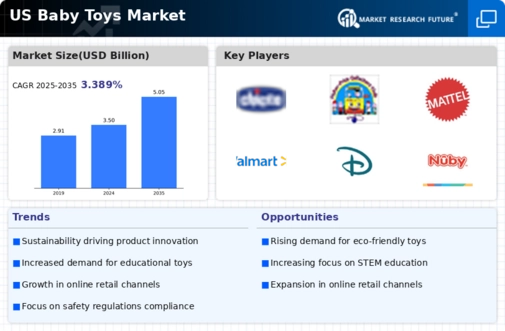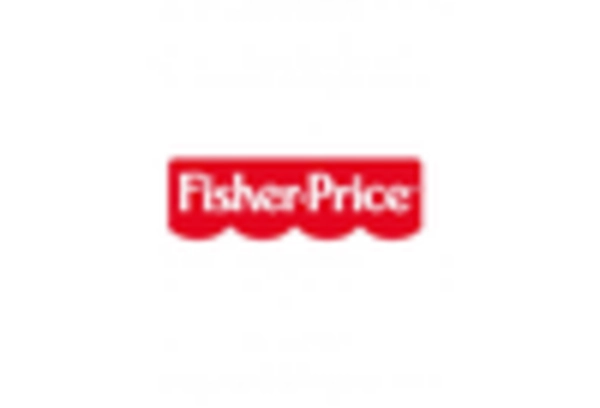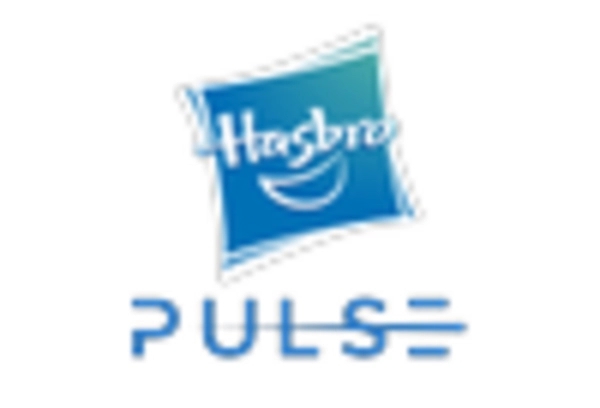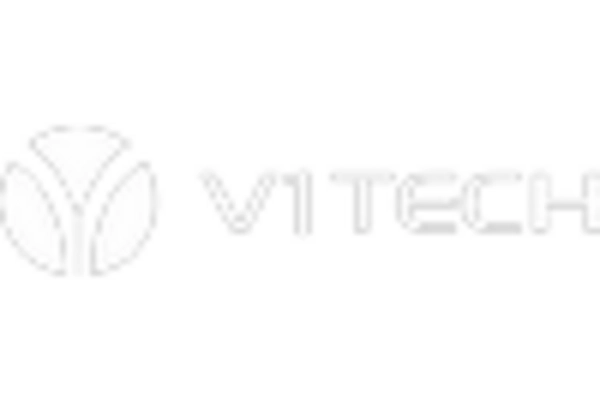The baby toys market in the US is characterized by a dynamic competitive landscape, driven by innovation, consumer preferences for educational products, and a growing emphasis on sustainability. Major players such as Mattel (US), Hasbro (US), and Fisher-Price (US) are at the forefront, each adopting distinct strategies to enhance their market positioning. Mattel (US) focuses on leveraging its iconic brands through digital transformation and interactive play experiences, while Hasbro (US) emphasizes partnerships with popular franchises to expand its product offerings. Fisher-Price (US), known for its developmental toys, is increasingly integrating technology into its products to cater to modern parenting trends. Collectively, these strategies contribute to a competitive environment that is both fragmented and concentrated, with key players vying for market share through innovation and brand loyalty.
In terms of business tactics, companies are increasingly localizing manufacturing to reduce supply chain vulnerabilities and enhance responsiveness to market demands. The market structure appears moderately fragmented, with several key players holding substantial shares, yet numerous smaller companies also competing effectively. This fragmentation allows for diverse product offerings, catering to various consumer preferences and price points, while the influence of major players remains significant in shaping market trends.
In October 2025, Mattel (US) announced a partnership with a leading tech firm to develop augmented reality (AR) toys aimed at enhancing interactive play. This strategic move is likely to position Mattel (US) as a pioneer in the integration of AR technology within the baby toys segment, potentially attracting tech-savvy parents looking for innovative play solutions. The collaboration underscores the importance of technological advancement in maintaining competitive advantage in a rapidly evolving market.
In September 2025, Hasbro (US) launched a new line of eco-friendly toys made from recycled materials, reflecting a growing consumer demand for sustainable products. This initiative not only aligns with global sustainability trends but also enhances Hasbro's (US) brand image as a responsible manufacturer. By prioritizing sustainability, Hasbro (US) may strengthen its market position and appeal to environmentally conscious consumers, thereby differentiating itself from competitors.
In August 2025, Fisher-Price (US) introduced a subscription service for its educational toys, allowing parents to receive curated toys tailored to their child's developmental stage. This innovative approach could foster customer loyalty and provide a steady revenue stream, while also addressing the needs of modern families seeking convenience. The subscription model may represent a shift in how consumers engage with toy brands, emphasizing ongoing relationships rather than one-time purchases.
As of November 2025, the competitive trends in the baby toys market are increasingly defined by digitalization, sustainability, and the integration of artificial intelligence (AI) into product development. Strategic alliances among companies are shaping the landscape, enabling them to pool resources and expertise to innovate more effectively. Looking ahead, competitive differentiation is likely to evolve from traditional price-based competition to a focus on innovation, technology integration, and supply chain reliability. Companies that can successfully navigate these trends may secure a more robust market position in the future.

















Leave a Comment